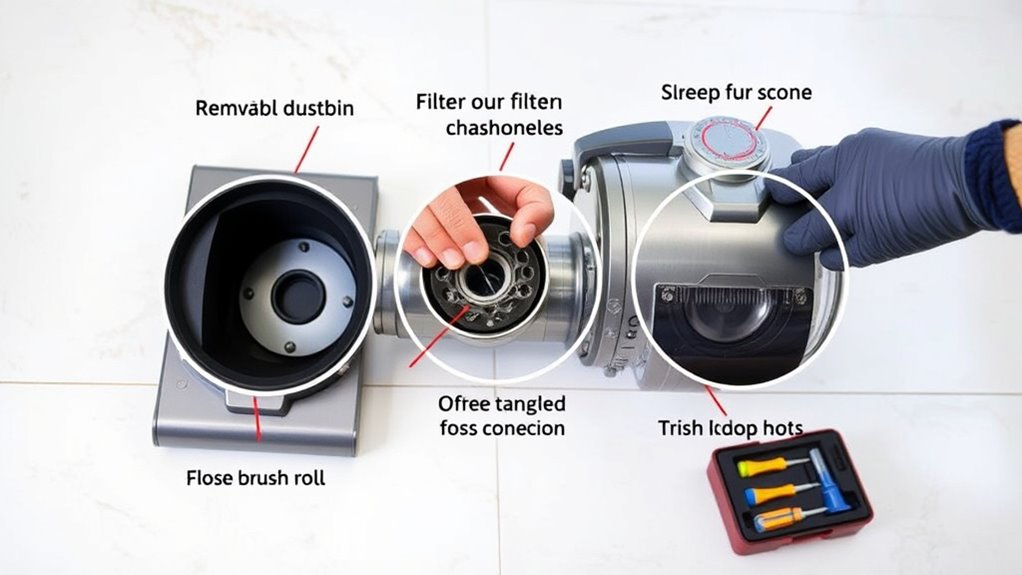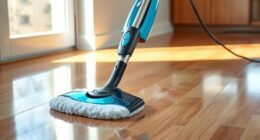To double your vacuum’s lifespan, start by regularly checking and replacing or cleaning filters to maintain airflow. Inspect the belt for signs of wear and replace it if needed to keep the brush spinning effectively. Clear any hair or string tangled around the brush roll to prevent damage. Tighten loose screws and inspect internal parts for wear. Following these simple steps can drastically improve your vacuum’s durability—keep going to discover more tips for lasting performance.
Key Takeaways
- Regularly clean or replace filters to maintain optimal airflow and prevent motor overheating.
- Inspect and replace worn belts to ensure the brush roll spins effectively.
- Clear hair and debris from the brush roll to prevent tangling and damage.
- Tighten loose screws and check for damaged parts to keep the vacuum running smoothly.
- Perform routine visual inspections to catch issues early and avoid costly repairs.

Regular maintenance is essential to keep your vacuum running efficiently and extend its lifespan. When you stay on top of simple tasks like filter replacements and belt inspections, you prevent many common issues that can cause breakdowns or reduce suction power. These small checks can make a big difference in how long your vacuum lasts and how well it performs day after day.
Start by paying attention to your vacuum’s filters. Over time, filters trap dust, dirt, and allergens, but they can become clogged or dirty. If you notice a decrease in suction or your vacuum isn’t cleaning as effectively, it’s time to replace or clean the filters. Many models have reusable filters that need regular washing, while others require replacing every few months. Keeping the filters clean or fresh ensures proper airflow and prevents the motor from overworking, which can cause overheating or damage. Don’t ignore this step — it’s quick, inexpensive, and considerably impacts your vacuum’s efficiency.
Next, perform belt inspections routinely. The belt drives the brush roll, helping it spin and agitate carpet fibers for a thorough clean. Over time, belts can stretch, crack, or wear down, especially if you often vacuum over rough surfaces or tangled hair. If you notice the brush isn’t spinning properly or if you hear slipping sounds, it’s likely time to check the belt. Turn off and unplug your vacuum before inspecting. Remove the brush roll and examine the belt for signs of wear or damage. If it’s cracked, frayed, or loose, replace it promptly. A worn belt not only diminishes cleaning power but can also cause the motor to overwork or overheat. Regular belt inspections help you catch these issues early, preventing more costly repairs down the line.
In addition to filters and belts, consider checking the brush roll itself for hair or string tangles that can hinder rotation. Clear out debris carefully, as tangled hair can damage the brush or belt. Also, ensure all screws and connections are tight — loose parts can cause vibrations or noise, reducing your vacuum’s effectiveness and lifespan. Performing these simple maintenance checks regularly can also prevent overheating, ensuring your vacuum remains in top condition longer.
Frequently Asked Questions
How Often Should I Replace My Vacuum’S Filters?
You should replace your vacuum’s filters based on the manufacturer’s recommended maintenance schedule, typically every 1 to 3 months. Regular filter replacement is essential for peak performance and air quality. Check your vacuum’s user manual for specific guidance. Keep an eye on filter condition—if it looks dirty or clogged, perform a filter replacement sooner. Staying consistent with your maintenance schedule guarantees your vacuum runs efficiently and lasts longer.
Can I Use Household Cleaning Products on My Vacuum?
Using household cleaners on your vacuum is like trying to fit a square peg in a round hole. You shouldn’t use household cleaning products because they can damage your vacuum’s components. Always check vacuum compatibility before applying any cleaners, and stick to manufacturer-recommended solutions. This guarantees your vacuum stays in top shape and lasts longer, avoiding costly repairs or replacements caused by incompatible household cleaners.
What’S the Best Way to Store My Vacuum Long-Term?
To guarantee proper vacuum storage and long-term preservation, you should clean the vacuum thoroughly before storing it. Store it in a cool, dry place away from direct sunlight to prevent damage. Keep the cord loosely wound to avoid strain, and cover the vacuum with a cloth or plastic cover to prevent dust buildup. Regularly check on it during storage to ensure it stays in good condition and ready for use.
How Do I Troubleshoot Common Vacuum Performance Issues?
Think of your vacuum like a car—if you ignore the basics, performance drops. When troubleshooting, check the vacuum belt; a worn or broken belt can cause loss of suction. Also, regularly inspect and clean the brush roller to prevent hair and debris buildup. These simple steps can solve common issues like poor suction or uneven cleaning, ensuring your vacuum runs smoothly and lasts longer.
Is It Safe to Vacuum Wet or Damp Surfaces?
You should never vacuum wet surfaces or use your vacuum for damp cleaning unless it’s specifically designed for that purpose. Standard vacuums are not waterproof and can short-circuit or become damaged if used on wet or damp surfaces. To keep your vacuum safe and functioning well, avoid moisture, and use a wet/dry vacuum if you need to clean up spills or damp areas. Always follow the manufacturer’s guidelines for safe use.
Conclusion
By performing these simple maintenance checks, you’re giving your vacuum the gift of longevity, turning it into a loyal workhorse that never quits. Think of your vacuum as a trusty steed—regular care keeps it galloping smoothly through every mess. Don’t let neglect turn it into a tired old nag. With just a little effort, you’ll keep your vacuum running like a finely tuned engine, ready to conquer dirt and debris for years to come.









